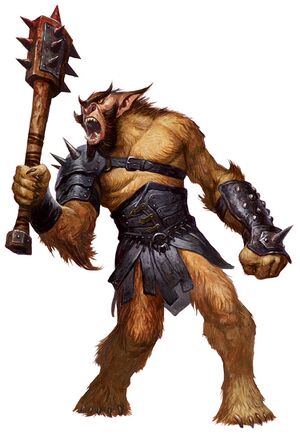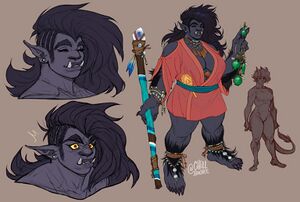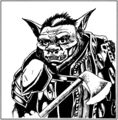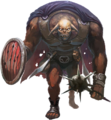Bugbear

Bugbear is a Middle English name for the same kind of basic dark fey or evil spirit more commonly referred to as a boogeyman; a malicious and scary monster that relishes in spreading fear to others. They are most relevant to /tg/ for their existence as one of the three major species of goblinoid in the worlds of Dungeons & Dragons (and by extension Pathfinder).
The D&D bugbear is the giant of the goblinoid races, reaching an imposing 7 feet tall - in fact, they were literally called "goblin-giants" when they debuted in the 1975 Greyhawk supplement for OD&D. If hobgoblins are the orcs of the goblinoid family tree, then bugbears are perhaps best described as its ogres. They resemble huge, bestial goblins, with exaggeratedly large ears, overgrown fangs, claw-like nails (though too small/brittle to be used as actual weapons), hair-covered skin, and "bear-like" noses - this is the source of their name.
Bugbears are often thought of as the dullest of the goblinoid core trilogy, since their basic "schtick" of being the Big Dumb Bruiser overlaps pretty thoroughly with that of the orcs and, later, the quaggoths. Yes, it's true bugbears do put a unique spin on it by being as quick and sneaky as they are strong; but on the surface, they just seem a bit too much like the traditional orc.
Ecology[edit | edit source]
As the most primitive of all goblinoids, bugbears have an impact on their surroundings somewhere between that of tribal humanoids and a pack of large predators. Strongly instinct-driven, bugbears are territorial creatures that stake out holdings surrounding caves or underground complexes, which they use for shelter. Carnivores, bugbears will eat the flesh of anything they can kill, including other sapient creatures - common goblins hate and fear their bigger cousins precisely because the bugbears will just as soon spitroast or stew a goblin as it will a frog, hare, pigeon or wild boar. Combined with their primitive love of shiny objects, bugbears are natural marauders, seeking to prey on anything around them for food and loot.
In return, bugbears are themselves on the food chain for even bigger and nastier creatures, such as giants and giant-kin, dragons, behirs, cave bears, etc. Combined with their relative lack of fertility, bugbears are thus encouraged to fall in line with their relative races for a support network to compensate. In Oerth's Underdark they're the drows' goons.
Society[edit | edit source]
On their own, bugbears tend to brutality to the point of bestiality. They band together in semi-nomadic gangs of hunter-gatherers; who frequently pillage, raid and plunder their surroundings, both for precious stones and metals and for captives. They are natural bullies and thugs, due to their aggression and territorial natures, being kept in line by the strongest and most aggressive of their kind. That's... about all what D&D has to say on bugbear society. So how are they different from any other 1970s-D&D humanoid?
The late-1970s Drow series mooted a halfhearted answer, posing the Depths' bugbears as slavers and slave-traders, serving the drow. Races of Ansalon, the Dragonlance splatbook that gives the most information on bugbears as a potential PC race, just goes back to thuggery. Here they rarely practice slavery, preferring to eat what they catch instead.
Despite this, bugbears actually aren't idiots. They readily integrate into more structured societies (although how well, and to which masters, depends somewhat on edition), and often take over goblin tribes to make them do the work for them. Bugbears are known to be part of the civilized goblinoid societies in Eberron, and the Nentir Vale even has an urban-dwelling bugbear tribe that has quite successfully remade itself into a crime syndicate.
AD&D lore claims that females are strictly inferior in bugbear society, which became a contrast with gnolls when the latter went full hyena. In 2e many bugbear adventurers are women looking for a better life outside of their repressive culture. This lore has been dropped in subsequent editions.
Religion[edit | edit source]
Bugbears worship their own loose pantheon, although details have never been forthcoming. The existence of such a pantheon of goblinoid deities first appeared in the AD&D 1e splatbook Deities & Demigods, which states that the bugbear pantheon consists of six deities, whose portfolios include earth, death, fertility, hunting and fear. However, only a single deity was statted in this book; Hruggek, chief of the pantheon, and the bugbear's god of Violence & Combat.
AD&D 2e's Monster Mythology would expand the bugbear pantheon with two other gods; Grankhul and Skiggaret. These are the only deities to have been defined for this pantheon since, and even Skiggaret fell under the wayside in 5th edition, though it clarified that the two, like all goblinoid gods, had been pressed into service under Maglubiyet.
Publication History[edit | edit source]
Bugbears first appeared for OD&D in the Greyhawk supplement. They then made it into the Monster Manual for Advanced Dungeons & Dragons and the Basic set for BECMI. They were updated to 2e in the Monstrous Compendium Appendix, which was reprinted in the Monstrous Manual. From Dungeons & Dragons 3rd Edition, 4th Edition and 5th Edition, they have appeared in the Monster Manual.
Monstergirls?[edit | edit source]

[1] Much like the hobgoblin, the idea of a bugbear monstergirl has never really been explored on /tg/. Perhaps partially due to the race's relative lack of a fanbase, or perhaps because the first thing to suggest itself for a bugbear-girl is basically a fluffy orc.
Ironically, the Complete Book of Humanoids for AD&D 2e does include a brief bit of fiction preceding the segment on how humanoid PCs could be a way to get milage out of the Reincarnation spell by describing an adventurer whose slain warrior-woman lover was brought back in the body of a female bugbear, and seemed uninclined to let her new shape get in the way of her love-life. Add to it that the same book also states that most adventuring bugbears are females trying to get away from the abusive patriarchal society of their kind and the old /tg/ tradition of "love can bloom on the battlefield", and it's surprising nobody on /tg/ has ever really mounted a serious campaign to make bugbear-girls a thing like goblin-girls...
4th edition did include a picture of a female bugbear in its Monster Manual. Aside from the surprisingly big breasts, she looks identical to her male counterpart.
PC Stats[edit | edit source]
BECMI[edit | edit source]
In BECMI, like the other goblinoids and iconic "humanoids" (orcs, gnolls, ogres, trolls), bugbears appear as a racial class in "The Orcs of Thar".
- Bugbear Ability Modifiers: +1 Strength, +1 Constitution, -2 Wisdom
- Note: Like all Humanoids from "The Orcs of Thar", a Bugbear has racial ability score caps of 18 in all scores bar Intelligence and Wisdom, which are capped at 16.
- Note: Like all Humanoids from "The Orcs of Thar", a Bugbear determines its Charisma score for interacting with humans and demihumans by dividing its Charisma score by 3 (rounding down) and subtracting the result from 9.
- Bugbear Natural Armor Class: 8
| Bugbear's's level | XP Required | Bugbear's hit dice |
|---|---|---|
| Youngster | -2,400 | d8+1 |
| Teenager | -1,200 | 2d8+1 |
| 0 | 0 | 3d8+1 |
| 1 | 2,400 | 4d8+2 |
| 2 | 7,200 | 5d8+2 |
| 3 | 16,600 | - |
| 4 | 35,600 | 6d8+2 |
| 5 | 73,600 | 7d8+3 |
| 6 | 147,600 | 8d8+3 |
| 7 | 297,600 | - |
| 8 | 597,600 | 9d8+3 |
| 9 | 897,600 | +2 Hit Points |
| Subsequent | 300,000 | +2 Hit Points |
AD&D[edit | edit source]
Bugbears are amongst the many races given a PC writeup for AD&D 2e in "The Complete Book of Humanoids".
- Ability Score Minimum/Maximum: Strength 8/18, Dexterity 8/17, Constitution 8/18, Intelligence 3/16, Wisdom 3/18, Charisma 3/14
- Ability Score Adjustments: +1 Strength, -1 Intelligence, -1 Charisma
- Racial Class & Level Limits: Fighter 12, Cleric 8, Shaman 5, Witch Doctor 5, Thief 9
- +3 Hit Points at 1st level.
- Infravision 60 feet
- Opponents suffer a -3 penalty to their surprise rolls against a bugbear.
- Bugbears take damage as if they were Large Creatures.
- Weapon Proficiencies: Throwing/Footman's Mace, Goblin Stick, Hand Axe, Morning Star, Great Club, Spear, Warhammer
- Nonweapon Proficiencies: Close-Quarter Fighting, Drinking, Eating, Hunting, Intimidation, Looting, Natural Fighting, Wild Fighting
3e[edit | edit source]
In 3e, bugbears - like orcs and goblinoids - had NPC stats right there in the original Monster Manual, along with some guidelines in the DMG for converting them into a semi-homebrew playable race. Their first writeup as a proper, out-of-the-box playable race was in Forgotten Realms: Races of Faerun. They were also eventually adapted into a monster class.
- +4 Strength, +2 Dexterity, +2 Constitution, –2 Charisma.
- Humanoid (goblinoid): Bugbears are humanoids with the goblinoid subtype.
- A bugbear’s base land speed is 30 feet.
- Darkvision out to 60 feet.
- Racial Hit Dice: A bugbear begins with three levels of humanoid, which provide 3d8 Hit Dice, a base attack bonus of +2, and base saving throw bonuses of Fort +1, Ref +3, and Will +1.
- Racial Skills: A bugbear’s humanoid levels give it skill points equal to 6 x (2 + Int modifier). Its class skills are Climb, Hide, Listen, Move Silently, Search, and Spot.
- Racial Feats: A bugbear’s humanoid levels give it two feats.
- +4 racial bonus on Move Silently checks.
- +3 natural armor bonus.
- Scent (Ex): A bugbear has a keen sense of smell. He can detect opponents within 30 feet given range (60 feet if the scent is upwind, 15 feet range if it is downwind) and may take a move-equivalent action to determine the direction of a scent. If an odor source is within 5 feet, the bugbear can pinpoint that source. Bugbears can use the scent ability to track an enemy by smell.
- Automatic Languages: Common, Goblin.
- Favored Class: Rogue.
- Level Adjustment: +1.
If using the bugbear monster class, bugbears start out with the following traits:
- +2 Strength, –2 Charisma.
- Bugbear base land speed is 30 feet.
- Darkvision out to 60 feet.
- Automatic Languages: Common, Goblin.
- Favored Class: Bugbear. A bugbear may not take levels in any other class except bugbear until he has gained all four bugbear racial class levels. Bugbears usually take levels in rogue or fighter after this point.
Class Skills: Climb, Hide, Listen, Move Silently, Search, Spot.
| Bugbear Class Level | Hit Dice | Base Attack Bonus | Fort Save | Ref Save | Will Save | Skill Points | CR | Special |
|---|---|---|---|---|---|---|---|---|
| 1st | 1d8 | +0 | +0 | +2 | +0 | (2 + Int mod) x 4 | 1 | Feat, +1 natural armor, +2 Move Silently |
| 2nd | 2d8 | +1 | +0 | +3 | +0 | 2+ Int mod | 1 | +2 Con, scent 10 ft., +4 Move Silently |
| 3rd | 2d8 | +1 | +0 | +3 | +0 | — | 2 | +2 Dex, +2 natural armor, scent 20 ft. |
| 4th | 3d8 | +2 | +1 | +3 | +1 | 2 + Int mod | 2 | Feat, +2 Str, +3 natural armor, scent 20 ft. |
4es[edit | edit source]
4e featured bugbear PC stats in the back of the first Monster Manual, although unlike the Hobgoblin (which got a "semi-official" upgrade in Dragon Magazine #419) and the Goblin (which got an "official" upgrade in the Dungeon Survival Guide), they never made it beyond this stage.
- Ability Scores: +2 Strength, +2 Dexterity
- Size: Medium
- Speed: 6 squares (30 feet)
- Vision: Low-light
- Languages: Common, Goblin
- Skill Bonuses: +2 Intimidate, +2 Stealth
- Oversized: You may use weapons of your size or one size larger than you as if they were your size.
- Racial Power - Predatory Eye: 1/encounter, as a minor action, you can grant yourself +1d6 bonus damage per tier on a single attack against a target that you have combat advantage against.
5e[edit | edit source]
- Ability Score Increase. Your Strength score increases by 2 and your Dexterity score increases by 1.
- Age. Bugbears reach adulthood at age 16 and live up to 80 years.
- Alignment: Bugbears endure a harsh existence that demands each of them to remain self-sufficient, even at the expense of their fellows. They tend to be chaotic evil.
- Size: Bugbears are between 6 and 8 feet tall and weigh between 250 and 350 pounds. Your size is Medium.
- Speed: Your base walking speed is 30 feet.
- Darkvision: You can see in dim light within 60 feet of you as if it were bright light, and in darkness as if it were dim light. You can't discern color in darkness, only shades of gray.
- Long Limbed: When you make a melee attack on your turn, your reach for it is 5 feet greater than normal.
- Powerful Build: You count as one size larger when determining your carrying capacity and the weight you can push, drag, or lift.
- Sneaky: You are proficient in the Stealth skill.
- Surprise Attack: If you surprise a creature and hit it with an attack on your first turn in combat, the attack deals an extra 2d6 damage to it. You can use this trait only once per combat.
- Languages: You can speak, read, and write Common and Goblin.
Mordekainen's Monsters of the Multiverse would rewrite this race, replacing the stat boosts with the generic stat boosts introduced in every book following Tasha's Cauldron of Everything, turning bugbears into Fey (including advantage to resisting the charmed condition) and letting them fit in places that would normally fit small creatures.
How to play as Lanky Kong in D&D 5e[edit | edit source]
- Step 1: Pick the bugbear race.
- Step 2: Pick the fighter class.
- Step 3: Take a glaive or other polearm as your starter weapon.
- Step 4: At lv 3, pick the battlemaster archetype.
- Step 5: Take the Lunging Attack Maneuver.
Congratulations, you can now slap people from up to 20ft away.
- Step 6 (optional): Become a town guard so you can make "Long Arm of the Law" puns.
Pumpkin-Headed Bugbears[edit | edit source]
Much like how in olden days breeds of Pigfaced Orcs and Dogfaced Kobolds could be found, and the term "Gnoll" referred to a hideous, lanky hobgoblin-like creature of mixed Gnome & Troll bloodline, so too did Bugbears have an odd appearance, of a head that resembled a squamous pumpkin, with a face reminiscent of a jack-o-lantern.
Citadel Bugbears[edit | edit source]
Games Workshop had its own version of Bugbears at one point. They were lanky, slightly taller than a human at full height but usually bowlegged and standing under a human's height, with big humanlike ears and bulging eyes, usually drooling and resembling Gollum's description but bigger. As for Warhammer Fantasy, the most recent "canon" mention of them was in a lore post for Vermintide 2 by Fatshark, where Lohner wrote "Old Saltzpyre will describe anything as “forbidden” or “cursed” if he gets even a wisp of something unsavoury. One of my biggest bugbears with the Order of the Silver Hammer, that."
See Also[edit | edit source]
Gallery[edit | edit source]
-
Greyhawk Supplement. Yes, the original bugbear had a pumpkin head.
-
1e
-
AD&D Monster Card
-
2e
-
3e
-
4e
-
5e, referencing OD&D's Pumpkinheads
-
Pathfinder
-
A proud bugbear with his quarry.
-
A lone Oldhammer bugbear.
-
A gang of Oldhammer bugbears.
| Dungeons & Dragons 1st Edition Races | |
|---|---|
| Basic Set | Dwarf • Elf • Hobbit • Human |
| Creature Crucible 1 | Brownie • Centaur • Dryad • Faun • Hsiao • Leprechaun • Pixie • Pooka • Redcap • Sidhe • Sprite • Treant • Wood Imp • Wooddrake |
| Creature Crucible 2 | Faenare • Gnome • Gremlin • Harpy • Nagpa • Pegataur • Sphinx • Tabi |
| Creature Crucible 3 | Kna • Kopru • Merrow • Nixie • Sea Giant • Shark-kin • Triton |
| Dragon Magazine | Cayma • Gatorman • Lupin • N'djatwa • Phanaton • Rakasta • Shazak • Wallara |
| Hollow World | Beastman • Brute-Man • Hutaakan • Krugel Orc • Kubitt • Malpheggi Lizard Man |
| Known World | Bugbear • Goblin • Gnoll • Hobgoblin • Kobold • Ogre • Troll |
| Dungeons & Dragons 2nd Edition Races | |
|---|---|
| Core | Dwarf • Elf • Gnome • Half-Elf • Half-Orc • Halfling • Human |
| Dark Sun | Aarakocra • Half-Giant • Mul • Pterran • Thri-kreen |
| Dragonlance | Draconian • Irda • Kender • Minotaur |
| Mystara | Aranea • Ee'ar • Enduk • Lizardfolk (Cayma • Gurrash • Shazak) • Lupin • Manscorpion • Phanaton • Rakasta • Tortle • Wallara |
| Oriental Adventures | Korobokuru • Hengeyokai • Spirit Folk |
| Planescape | Aasimar • Bariaur • Genasi • Githyanki • Githzerai • Modron • Tiefling |
| Spelljammer | Dracon • Giff • Grommam • Hadozee • Hurwaeti • Rastipede • Scro • Xixchil |
| Ravenloft: | Broken One • Flesh Golem • Half-Vistani • Therianthrope |
| Complete Book Series | Alaghi • Beastman • Bugbear • Bullywug • Centaur • Duergar • Fremlin • Firbolg • Flind • Gnoll • Goblin • Half-Ogre • Hobgoblin • Kobold • Mongrelfolk • Ogre • Ogre Mage • Orc • Pixie • Satyr • Saurial • Svirfneblin • Swanmay • Voadkyn • Wemic |
| Dragon Magazine | Half-Dryad • Half-Satyr • Uldra • Xvart |
| Dungeons & Dragons 4th Edition Races | |
|---|---|
| Player's Handbook 1 | Dragonborn • Dwarf • Eladrin • Elf • Half-Elf • Halfling • Human • Tiefling |
| Player's Handbook 2 | Deva • Gnome • Goliath • Half-Orc • Shifter |
| Player's Handbook 3 | Githzerai • Minotaur • Shardmind • Wilden |
| Monster Manual 1: | Bugbear • Doppelganger • Githyanki • Goblin • Hobgoblin • Kobold • Orc |
| Monster Manual 2 | Bullywug • Duergar • Kenku |
| Dragon Magazine | Gnoll • Shadar-kai |
| Heroes of Shadow | Revenant • Shade • Vryloka |
| Heroes of the Feywild | Hamadryad • Pixie • Satyr |
| Eberron's Player's Guide | Changeling • Kalashtar • Warforged |
| The Manual of the Planes | Bladeling |
| Dark Sun Campaign Setting | Mul • Thri-kreen |
| Forgotten Realms Player's Guide | Drow • Genasi |














